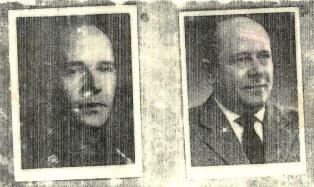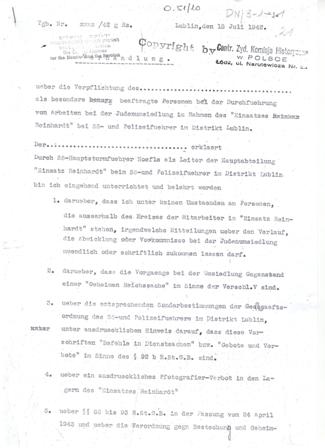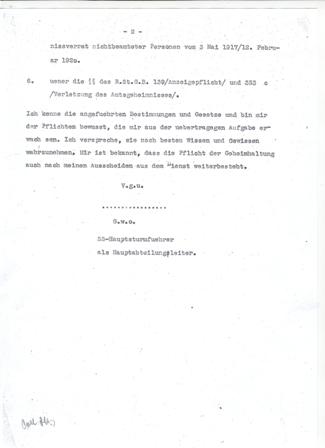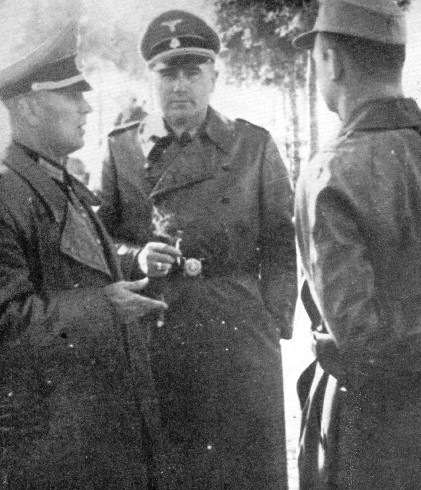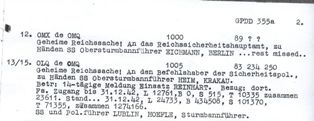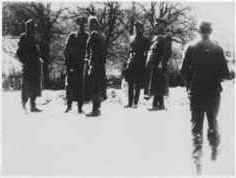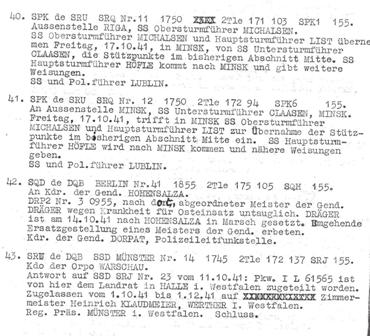Holocaust Education & Archive Research Team |
Aktion Reinhard
A-R Leadership
A-R Articles
Action Erntefest Modern Research
| |||
Herman Julius Höfle
Herman Julius Höfle was born in Salzburg on 19 June 1911. He joined the NSDAP on 1 August 1933, with party number 307,469, having been a member of the Austrian Nazi party, three years earlier. As well as being a trained mechanic, he had been a Salzburg taxi driver, and at one point even owned a taxi company.
Höfle went on to join the SS and during the latter months of 1935 until January 1936, served time in a Salzburg police prison. A year later he headed Sturmbann 1/76, a unit of the SS. His first action was the Kristallnacht, which so impressed Eichmann that he recommended him to Odilo Globocnik, the Gauleiter of Vienna.
After being trained at the officer’s school in Dachau, Höfle served briefly in the Sudetenland prior to the outbreak of the Second World War. After the invasion he served in the Selbschutz in Nowy Sacz, in Southern Poland.
Following this from November 1940 he served as an overseer of Jewish work camps working on the frontier fortifications, a network of huge anti-tank ditches, near Belzec, which was of course, within a couple of years the site of the first Action Reinhard death camps.
Höfle along with a number of other key players in Action Reinhard were also involved in the construction of SS and Police bases, in the newly occupied eastern areas. During 1941, Höfle was in Mogilew. After this he was sent back to the Lublin area, where he was involved in the early planning of Aktion “Reinhard”
On the 16 March 1942 he participated in the meeting of the SS-men from “Aktion Reinhard” and the members of the German civil administration when they discussed how to organise the deportations to Belzec.
Höfle, as Globocnik’s Chief of Staff for Aktion Reinhard, and according to another member of the Aktion Reinhard staff, Georg Michalsen, lived in the Julius Schreck Barracks :
“The staff building was a three story house. On the ground floor – immediately by the entrance – there was the transport squad. On the first floor – on one side – there was the administration, accounts, and archive (documents) office.
Here the Chief of Staff also had a room and an ante-room. On the second floor there was located the personnel department. Here Herman Höfle also had his living quarters in one room.”
Höfle as Chief of Staff, made all recruits to sign a secrecy pledge, on joining Action Reinhard service, a copy is attached. Herman Höfle, played a major role in deportation actions in Mielec, Lublin, Rzeszow, Warsaw and Bialystok, as well as escorting Adolf Eichmann, to the Belzec and Treblinka Death Camps.
He was also responsible for the reception of transports to Lublin district from Germany, Theresienstadt and Slovakia. According to some testimonies he personally selected young men from these transports and sent them mainly to Majdanek concentration camp.
It was in accordance with his order about the selections of all transports, which were sent to the transit ghettos or directly to the death camps in Belzec and Sobibor. These selections were organised in Lublin (on the ramp in Flugplatz) or in Naleczow railway station (30 km. from Lublin) from which the transports were sent to the transit ghetto in Opole Lubelskie, Konskowola or Deblin or directly to the death camp in Sobibor. The selections in Naleczow were organised when the Slovakian transports arrived to Lublin district.
The procedures he was involved in during the first weeks of Aktion “Reinhard”, were replayed later during the deportations from other ghettos, mainly from the Warsaw ghetto. His activity in clearing the Warsaw Ghetto is well documented, after one week of arriving in Warsaw, at 10.00 am on Wednesday 22 July 1942, Höfle and his aides appeared at the Judenrat Headquarters.
Höfle informed Czerniakow, the Chairman of the Warsaw Judenrat, “that all the Jews irrespective of sex and age, with certain exceptions, will be deported to the East. By 4pm today a contingent of 6,000 people must be provided. And this, at the minimum, will be the daily quota.
In his statement, Zygmunt Warman, the member of the Warsaw`s Judenrat told that during this meeting with Czerniakow, Höfle ordered the Judenrat to prepare wooden boxes – 150x70 cm. “It was very strange order for us. Much later we realised that they were the boxes for gathering the valuables in Treblinka, the gold teeth and jewellery which were plundered and which did not go directly to the pockets of the hangmen.”
At midday official wall posters appeared in the streets of the ghetto, dictated by Höfle, but prepared by the Judenrat, under orders. Throughout the “Great Action” in Warsaw ghetto, according to the memoirs by Samuel Puterman, Höfle visited the streets of the ghetto and Umschlagplatz. He was indifferent to what he saw, except the number of the deportees to Treblinka.
Every evening some SS-Unterscharführer who was responsible for counting the numbers of the people who were loaded to the trains, gave his report to Höfle about the daily statistic of the Jews who were deported to Treblinka. Probably the same procedure was organised during the deportations from other ghettos and the reports about the numbers of the victims were sent to the Höfle`s office in Lublin.
Höfle knew exactly about the conditions in the transports and he knew that many people died before they arrived at the camps. He knew also that in Warsaw ghetto within a short time the rumours spread about Treblinka because some deportees who had been at the camp, escaped and returned to the ghetto.
According to Georg Michalsen, Höfle told him that "it made no sense to keep the destination of the transports a secret, if every Jew knew about it”.
Höfle had three children, but two his children, twins died of a disease in Lublin, at the graveside, overcome with grief, Höfle exclaimed. “This is the punishment for the children of Warsaw”.
Höfle continued in Lublin, after Globocnik had left for Trieste, in September 1943, and was heavily implicated in the Operation Erntefest (Harvest Festival) in November 1943, which saw the liquidation of the Jewish Labour Camps in the Lublin district. After departing Lublin, Höfle served time in Oranienburg , Brussels and the Netherlands, but rejoined Globocnik in Trieste.
Höfle was with Globocnik when he committed suicide in Paternion, Carinthia , on 31st May 1945, and was photographed by the British. He was interrogated by the British in captivity. During his interrogation, he clearly lied about his role in the destruction of Jews in Poland:
Summary Statement - Transcript
Herman Hoeflle was born in Salzburg 19 June 1911. After the annexation of Austria he became a full time worker in the General SS. In 1939 he entered the Waffen – SS – after the end of the war he was turned over to the Austrians by the English- he was released on parole in October 1947.
Informant worked for Globocnik from 1941 to 1943 in the Office for the Construction of SS and Police Strong Points in the East area. It was planned to construct strong points in which units could be stationed with their families. Billets were built but the whole plan was not carried out.
Informant had to supply the guards- he had a battalion consisting of racial Germans and some Russians. Informant claims he was never in Warsaw. Globocnik was not competent for Warsaw. The 5th district (Krakau, Lemberg and Warschau) had its own SS and Police Leader.
Informant has three children living in Salzburg – two of his children died in 1942 and are buried in Lublin. Informant claims that he never saw any Jews being evacuated while the Strong Points were being constructed.
In Minsk the city section Nord-Kaserne was used. There was also a settlement in Lublin, informant claims that he only drove through there once, he had nothing to do with these people.
Interrogated by Mr H. Meyer
Date: 15 December 1947. Nuremburg
Höfle was released and not immediately brought to justice and lived in Italy, Austria and Germany, but he was arrested in 1961 in Salzburg. Höfle was transferred from Salzburg to Vienna, but ten weeks after his transfer, on 20 August 1962 he committed suicide, by hanging himself, in his solitary cell.
Sources:
Hitler’s Man in the East, by Joseph Poprzeczny, published by McFarland & Company, Jefferson North Carolina 2004 Justice not Vengeance, by Simon Wisenthal, published by Weidenfeld and Nicolson London 1989 The Jews of Warsaw, by Yisrael Gutman, published by The Harvester Press, Brighton 1982 Yad Vashem Public Records Office (PRO –Kew) Institute of the National Memory in Warsaw, Documents of the Investigations in the Case against Karl Georg Brandt. Bundesarchiv in Ludwigsburg. Investigation against Georg Michalsen. Memoirs by Samuel Puterman (in) Pamietniki z getta warszawskiego. Fragmenty I regesty (Memoirs from Warsaw`s Ghetto. Fragments). Ed. by M. Grynberg. Warszawa 1993. US National Archives Washington. Holocaust Historical Society
Copyright. Chris Webb & Robert Kuwalek H.E.A.R.T 2007
|
